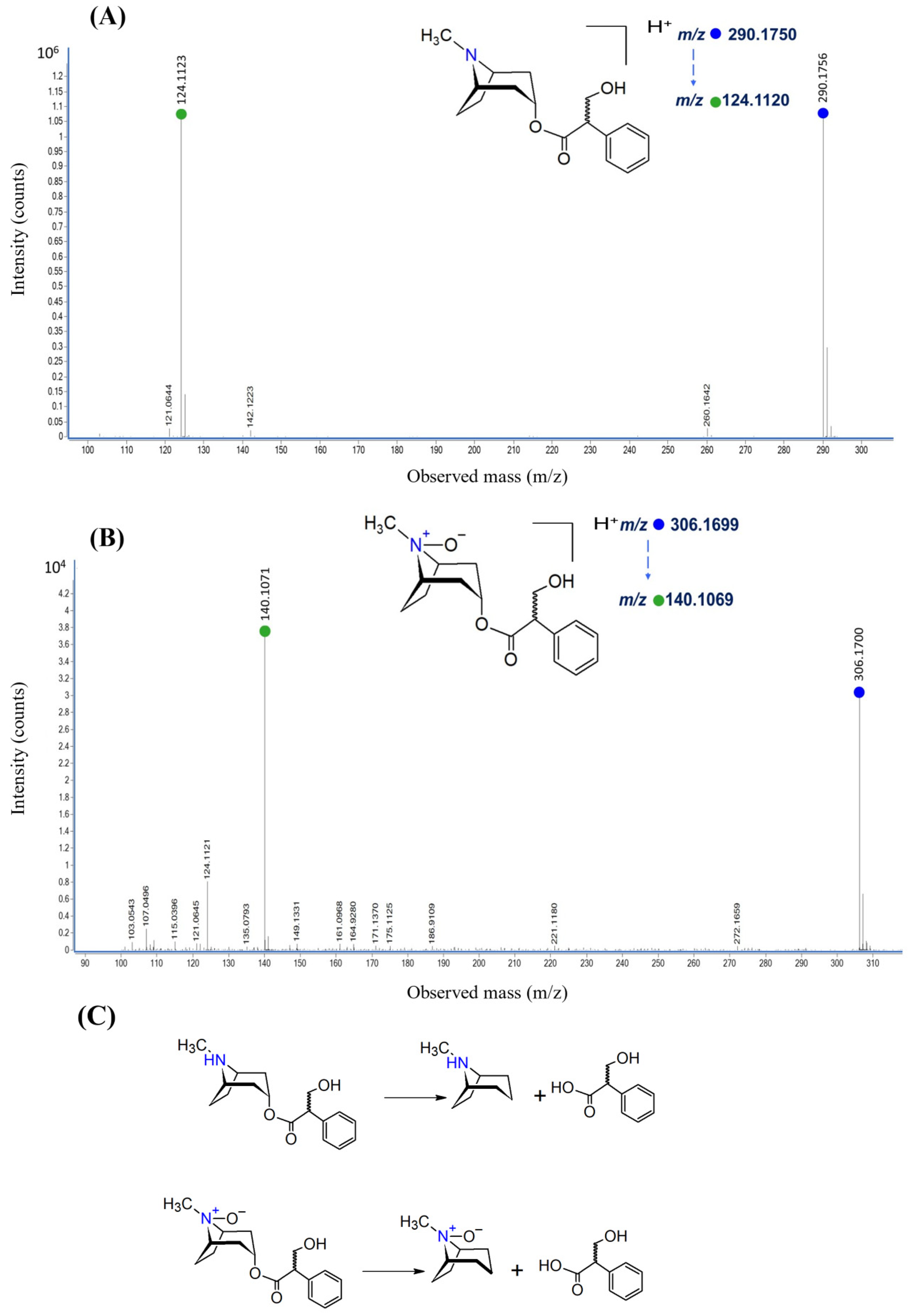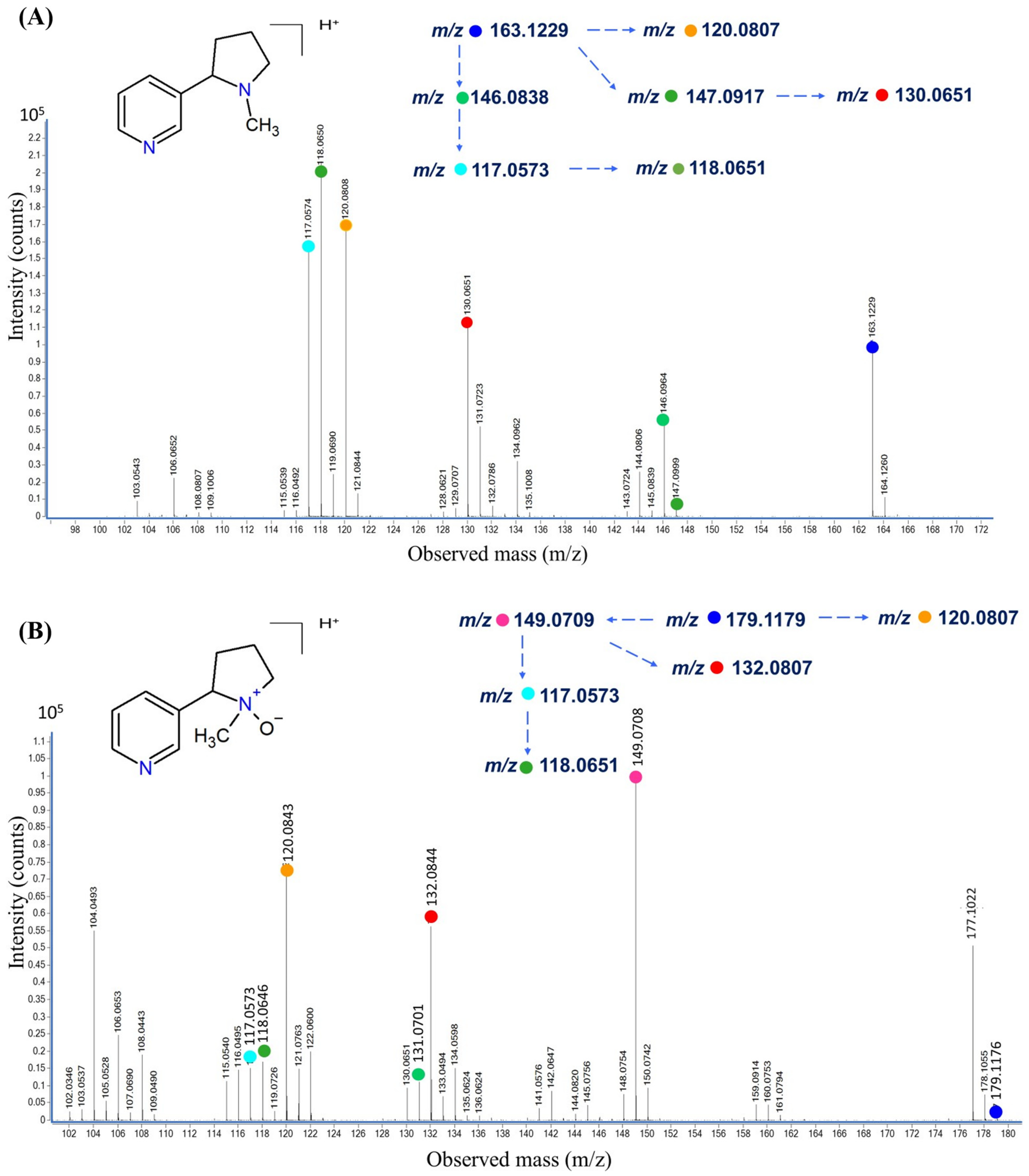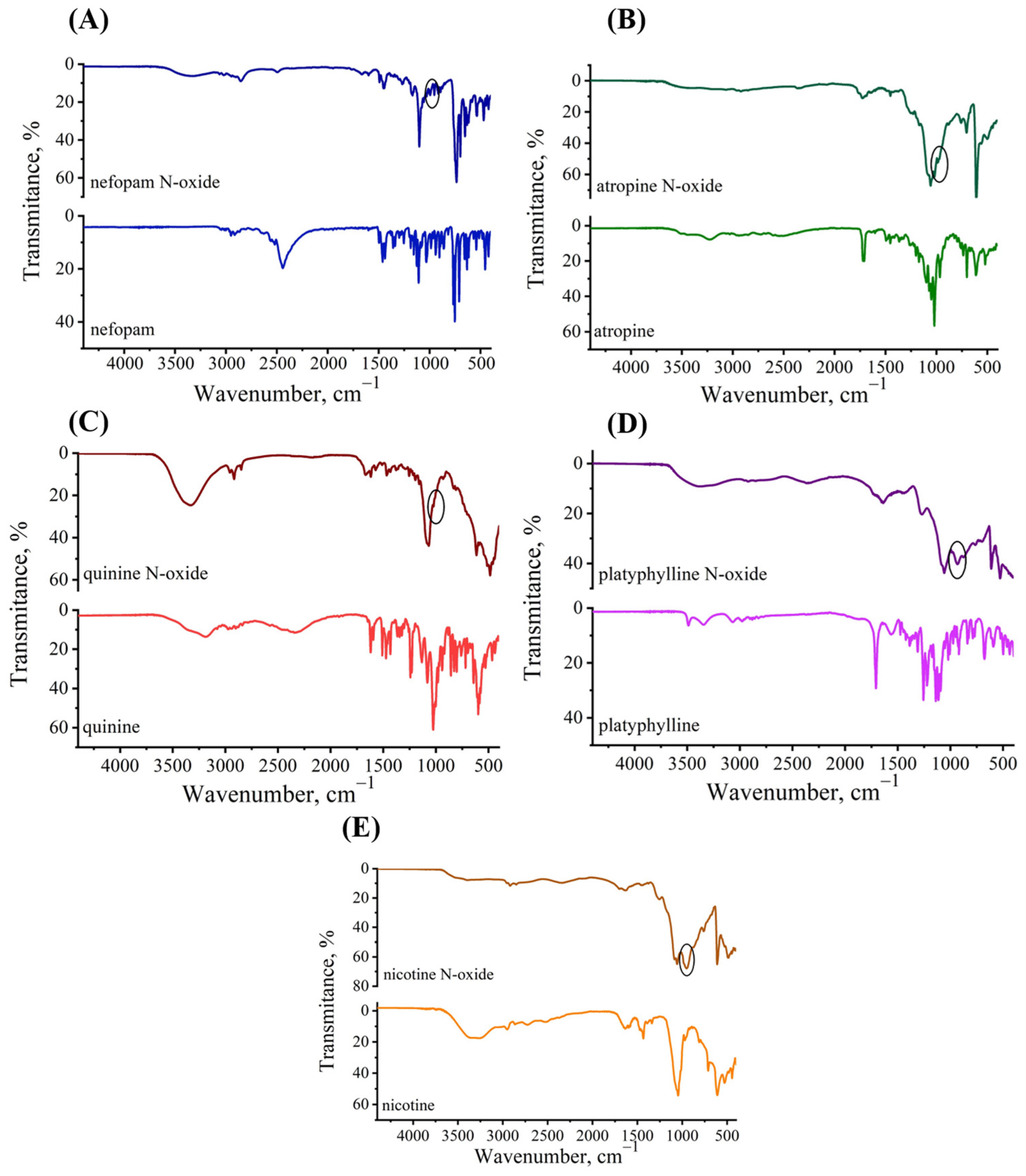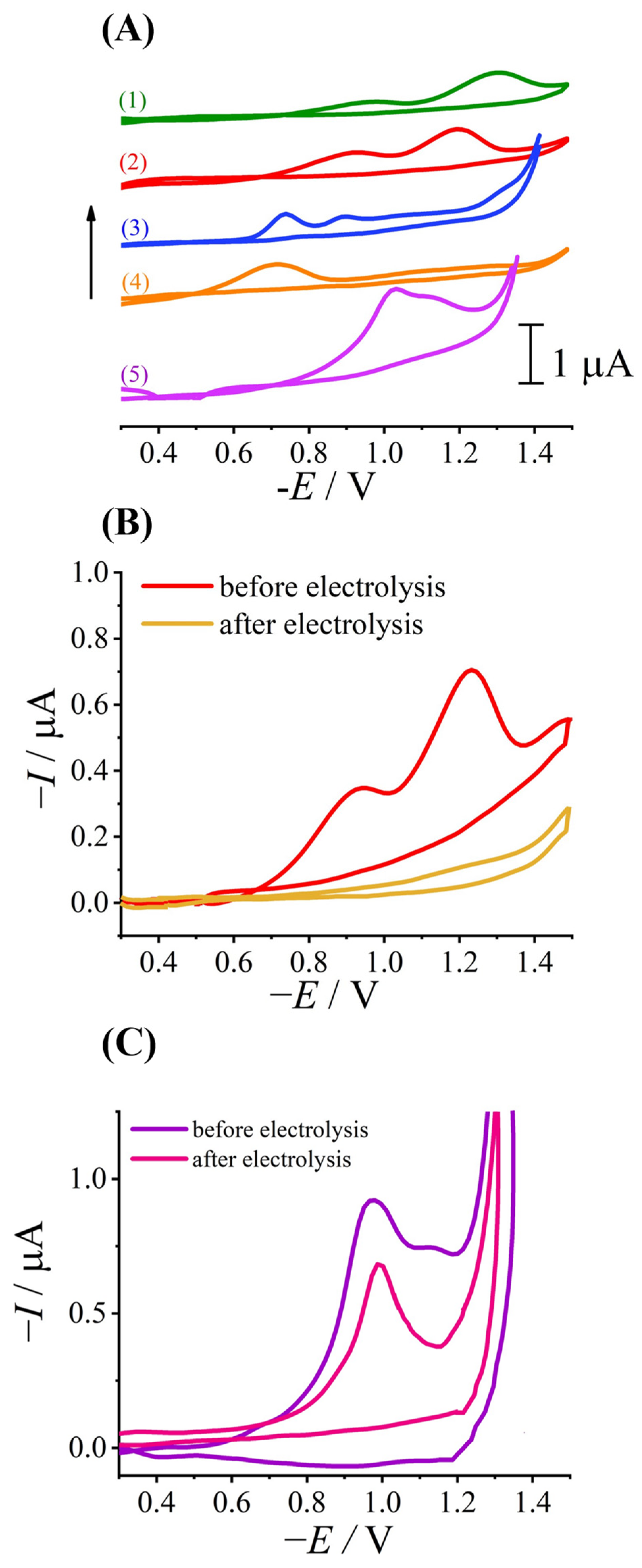Structural Characterization and Electrochemical Studies of Selected Alkaloid N-Oxides
Abstract
:1. Introduction
2. Results and Discussion
2.1. Synthesis of Alkaloid N-Oxides
2.2. Studies on Structure of Alkaloid N-Oxides by Mass Spectrometry
2.2.1. Nefopam and Nefopam N-Oxide
2.2.2. Atropine and Atropine N-Oxide
2.2.3. Quinine and Quinine N-Oxide
2.2.4. Nicotine and Nicotine N-Oxide
2.3. Studies on Structure of N-Oxide Alkaloids by FT-IR Spectrometry
2.4. Study of Alkaloid N-Oxide Reduction with the Electrochemical Approach
3. Materials and Methods
3.1. Chemical and Reagents
3.2. Instrumentation
3.2.1. Mass Spectrometry
3.2.2. FT-IR Spectroscopy
3.2.3. Electrochemistry
4. Conclusions
Supplementary Materials
Author Contributions
Funding
Institutional Review Board Statement
Informed Consent Statement
Data Availability Statement
Acknowledgments
Conflicts of Interest
References
- Manna, K.; Somraj Singh, W.; Goswami, S.; Ashif Ikbal, A.M.; Rajkhowa, A.; Debnath, B. Metabolites Study of Experimental Plant Derived Alkaloids: A Review. Nat. Prod. J. 2023, 13, 64–78. [Google Scholar] [CrossRef]
- Kurek, J. Introductory Chapter: Alkaloids—Their Importance in Nature and for Human Life. In Alkaloids—Their Importance in Nature and Human Life; IntechOpen: London, UK, 2019. [Google Scholar]
- Rajput, A.; Sharma, R.; Bharti, R. Pharmacological Activities and Toxicities of Alkaloids on Human Health. Mater. Today Proc. 2022, 48, 1407–1415. [Google Scholar] [CrossRef]
- Faisal, S.; Badshah, S.L.; Kubra, B.; Emwas, A.-H.; Jaremko, M. Alkaloids as Potential Antivirals. A Comprehensive Review. Nat. Prod. Bioprospect. 2023, 13, 4. [Google Scholar] [CrossRef]
- Russo, M.; Moccia, S.; Spagnuolo, C.; Tedesco, I.; Russo, G.L. Roles of Flavonoids against Coronavirus Infection. Chem. Biol. Interact. 2020, 328, 109211. [Google Scholar] [CrossRef]
- Aryal, B.; Raut, B.K.; Bhattarai, S.; Bhandari, S.; Tandan, P.; Gyawali, K.; Sharma, K.; Ranabhat, D.; Thapa, R.; Aryal, D.; et al. Potential Therapeutic Applications of Plant-Derived Alkaloids against Inflammatory and Neurodegenerative Diseases. Evid.-Based Complement. Altern. Med. 2022, 2022, 1–18. [Google Scholar] [CrossRef]
- Tuzimski, T.; Petruczynik, A. New Trends in the Practical Use of Isoquinoline Alkaloids as Potential Drugs Applicated in Infectious and Non-Infectious Diseases. Biomed. Pharmacother. 2023, 168, 115704. [Google Scholar] [CrossRef]
- M Mostafa, E.; Gamal, M.; M Ghoneim, M.; Hussein, S.; H El-Ghorab, A.; A Abdelgawad, M.; Musa, A. Repurposing of FDA Approved Alkaloids as COVID 19 Inhibitors; in Silico Studies. Pharmacogn. J. 2021, 13, 110–123. [Google Scholar] [CrossRef]
- Wink, M. Potential of DNA Intercalating Alkaloids and Other Plant Secondary Metabolites against SARS-CoV-2 Causing COVID-19. Diversity 2020, 12, 175. [Google Scholar] [CrossRef]
- Akinboye, A.J.; Kim, K.; Choi, S.; Yang, I.; Lee, J.-G. Alkaloids in Food: A Review of Toxicity, Analytical Methods, Occurrence and Risk Assessments. Food Sci. Biotechnol. 2023, 32, 1133–1158. [Google Scholar] [CrossRef]
- Beyer, J.; Drummer, O.H.; Maurer, H.H. Analysis of Toxic Alkaloids in Body Samples. Forensic Sci. Int. 2009, 185, 1–9. [Google Scholar] [CrossRef]
- Koleva, I.I.; van Beek, T.A.; Soffers, A.E.M.F.; Dusemund, B.; Rietjens, I.M.C.M. Alkaloids in the Human Food Chain—Natural Occurrence and Possible Adverse Effects. Mol. Nutr. Food Res. 2012, 56, 30–52. [Google Scholar] [CrossRef]
- Schrenk, D.; Gao, L.; Lin, G.; Mahony, C.; Mulder, P.P.J.; Peijnenburg, A.; Pfuhler, S.; Rietjens, I.M.C.M.; Rutz, L.; Steinhoff, B.; et al. Pyrrolizidine Alkaloids in Food and Phytomedicine: Occurrence, Exposure, Toxicity, Mechanisms, and Risk Assessment—A Review. Food Chem. Toxicol. 2020, 136, 111107. [Google Scholar] [CrossRef]
- de Nijs, M.; Crews, C.; Dorgelo, F.; MacDonald, S.; Mulder, P.P.J. Emerging Issues on Tropane Alkaloid Contamination of Food in Europe. Toxins 2023, 15, 98. [Google Scholar] [CrossRef]
- Gumus, Z.P. Assessment of Toxic Pyrrolizidine and Tropane Alkaloids in Herbal Teas and Culinary Herbs Using LC-Q-ToF/MS. Foods 2023, 12, 3572. [Google Scholar] [CrossRef]
- The European Commission. Commission Regulation (EU) 2021/1399 of 24 August 2021 Amending Regulation (EC) No 1881/2006 as Regards Maximum Levels of Ergot Sclerotia and Ergot Alkaloids in Certain Foodstuffs; The European Commission: Brussels, Belgium, 2021. [Google Scholar]
- The European Commission. Commission Regulation (EU) 2020/2040 of 11 December 2020 Amending Regulation (EC) No 1881/2006 as Regards Maximum Levels of Pyrrolizidine Alkaloids in Certain Foodstuffs; The European Commission: Brussels, Belgium, 2020. [Google Scholar]
- The European Commission. Commission Regulation (EU) 2016/239 of 19 February 2016 Amending Regulation (EC) No 1881/2006 as Regards Maximum Levels of Tropane Alkaloids in Certain Cereal-Based Foods for Infants and Young Children; The European Commission: Brussels, Belgium, 2016. [Google Scholar]
- Robinson, T. The Metabolism and Biochemical Actions of Alkaloids in Animals. Stud. Nat. Prod. Chem. 2000, 22, 3–54. [Google Scholar]
- Dusemund, B.; Nowak, N.; Sommerfeld, C.; Lindtner, O.; Schäfer, B.; Lampen, A. Risk Assessment of Pyrrolizidine Alkaloids in Food of Plant and Animal Origin. Food Chem. Toxicol. 2018, 115, 63–72. [Google Scholar] [CrossRef]
- Fu, P.P.; Chou, M.W.; Xia, Q.; Yang, Y.-C.; Yan, J.; Doerge, D.R.; Chan, P.C. Genotoxic Pyrrolizidine Alkaloids and Pyrrolizidine Alkaloid N-Oxides—Mechanisms Leading to DNA Adduct Formation and Tumorigenicity. J. Environ. Sci. Health Part C 2001, 19, 353–385. [Google Scholar] [CrossRef]
- He, Y.; Zhu, L.; Ma, J.; Lin, G. Metabolism-Mediated Cytotoxicity and Genotoxicity of Pyrrolizidine Alkaloids. Arch. Toxicol. 2021, 95, 1917–1942. [Google Scholar] [CrossRef]
- Hukkanen, J.; Jacob, P.; Benowitz, N.L. Metabolism and Disposition Kinetics of Nicotine. Pharmacol. Rev. 2005, 57, 79–115. [Google Scholar] [CrossRef]
- Park, S.B.; Jacob, P.; Benowitz, N.L.; Cashman, J.R. Stereoselective Metabolism of (S)-(-)-Nicotine in Humans: Formation of Trans-(S)-(-)-Nicotine N-1′-Oxide. Chem. Res. Toxicol. 1993, 6, 880–888. [Google Scholar] [CrossRef]
- Benowitz, N.L.; Griffin, C.; Tyndale, R. Deficient C-Oxidation of Nicotine Continued. Clin. Pharmacol. Ther. 2001, 70, a120252. [Google Scholar] [CrossRef]
- Widjaja, F.; Zheng, L.; Wesseling, S.; Rietjens, I.M.C.M. Physiologically Based Kinetic Modeling of Senecionine N-Oxide in Rats as a New Approach Methodology to Define the Effects of Dose and Endpoint Used on Relative Potency Values of Pyrrolizidine Alkaloid N-Oxides. Front. Pharmacol. 2023, 14, 1125146. [Google Scholar] [CrossRef]
- Potęga, A.; Göldner, V.; Niehaves, E.; Paluszkiewicz, E.; Karst, U. Electrochemistry/Mass Spectrometry (EC/MS) for Fast Generation and Identification of Novel Reactive Metabolites of Two Unsymmetrical Bisacridines with Anticancer Activity. J. Pharm. Biomed. Anal. 2023, 235, 115607. [Google Scholar] [CrossRef]
- Li, Z.; Shen, F.; Mishra, R.K.; Wang, Z.; Zhao, X.; Zhu, Z. Advances of Drugs Electroanalysis Based on Direct Electrochemical Redox on Electrodes: A Review. Crit. Rev. Anal. Chem. 2024, 54, 269–314. [Google Scholar] [CrossRef]
- Rogowska, A.; Pomastowski, P.; Szultka-Młyńska, M.; Walczak-Skierska, J.; Rafińska, K.; Rafiński, Z.; Buszewski, B. Investigation of the Mechanism of Zearalenone Metabolization in Different Systems: Electrochemical and Theoretical Approaches. Toxicon 2022, 210, 19–24. [Google Scholar] [CrossRef]
- Grint, I.; Crea, F.; Vasiliadou, R. The Combination of Electrochemistry and Microfluidic Technology in Drug Metabolism Studies. ChemistryOpen 2022, 11, e202200100. [Google Scholar] [CrossRef]
- Herl, T.; Matysik, F. Recent Developments in Electrochemistry–Mass Spectrometry. ChemElectroChem 2020, 7, 2498–2512. [Google Scholar] [CrossRef]
- Rodrigues, M.O.; Eberlin, M.N.; Neto, B.A.D. How and Why to Investigate Multicomponent Reactions Mechanisms? A Critical Review. Chem. Rec. 2021, 21, 2762–2781. [Google Scholar] [CrossRef]
- Blazheyevskiy, M. Application of Derivatization by Means of Peroxy Acid Oxidation and Perhydrolysis Reactions in Pharmaceutical Analysis; Ivan Franko National University of Lviv: Lviv, Ukraine, 2017. [Google Scholar]
- Aisyah, A.; Tamaela, N.B.; Santoso, J.; Syah, Y.M.; Mujahidin, D. Synthesis of Quinine N-Oxide and an NMR Tutorial in Its Structure Determination. J. Sains Teh Dan Kina 2016, 17, 11–20. [Google Scholar] [CrossRef]
- Fawzy, A. Oxidative Degradation of Atropine Drug by Permanganate Ion in Perchloric and Sulfuric Acid Solutions: A Comparative Kinetic Study. Adv. Biochem. 2016, 4, 58. [Google Scholar] [CrossRef]
- Ogawa, T.; Niwa, H.; Yamada, K. An Efficient Enantioselective Synthesis of Indicine N-Oxide, an Antitumor Pyrrolizidine Alkaloid. Tetrahedron 1993, 49, 1571–1578. [Google Scholar] [CrossRef]
- Vaz, N.; Manjunatha, A.S. Mechanistic Insight into the Oxidation of Atropine Sulfate Monohydrate with Aqueous Acidic Chloramine-T: Design of Kinetic Modeling. Bulg. Chem. Commun. 2016, 48, 671–677. [Google Scholar]
- Meti, M.D.; Nandibewoor, S.T.; Chimatadar, S.A. Spectroscopic Investigation and Reactivities of Ruthenium(III) Catalyzed Oxidation of Anticholinergic Drug Atropine Sulfate Monohydrate by Hexacyanoferrate(III) in Aqueous Alkaline Media: A Mechanistic Approach. Synth. React. Inorg. Met. Nano-Met. Chem. 2014, 44, 263–272. [Google Scholar] [CrossRef]
- Dubenska, L.; Dushna, O.; Pysarevska, S.; Blazheyevskiy, M. A New Approach for Voltammetric Determination of Nefopam and Its Metabolite. Electroanalysis 2020, 32, 626–634. [Google Scholar] [CrossRef]
- Dubenska, L.O.; Dushna, O.M.; Plyska, M.V.; Blazheyevskіy, M.Y. Method of Polarographic Determination Of Platyphylline In A Form Of N-Oxide And Its Validation In Solution For Injection. Methods Objects Chem. Anal. 2020, 15, 83–92. [Google Scholar] [CrossRef]
- Dubenska, L.; Dushna, O.; Blazheyevskiy, M.; Pysarevska, S.; Klymiuk, I. Kinetic and Polarographic Study on Atropine N-Oxide: Its Obtaining and Polarographic Reduction. Chem. Pap. 2021, 75, 4147–4155. [Google Scholar] [CrossRef]
- Dushna, O.; Dubenska, L.; Plotycya, S.; Rydchuk, M.; Blazheyevskiy, M. The Alternative Voltammetric Method for the Determination of Nicotine and Its Metabolite Nicotine N-Oxide. J. Electrochem. Soc. 2022, 169, 016513. [Google Scholar] [CrossRef]
- Gawor, A.; Bulska, E. A Standardized Protocol for Assuring the Validity of Proteomics Results from Liquid Chromatography–High-Resolution Mass Spectrometry. Int. J. Mol. Sci. 2023, 24, 6129. [Google Scholar] [CrossRef]
- Köfeler, H.C.; Gross, M.L. Correction of Accurate Mass Measurement for Target Compound Verification by Quadrupole Time-of-Flight Mass Spectrometry. J. Am. Soc. Mass. Spectrom. 2005, 16, 406–408. [Google Scholar] [CrossRef]
- Yu, J.; Solon, E.; Shen, H.; Modi, N.B.; Mittur, A. Pharmacokinetics, Distribution, Metabolism, and Excretion of the Dual Reuptake Inhibitor [14C]-Nefopam in Rats. Xenobiotica 2016, 46, 1026–1048. [Google Scholar] [CrossRef]
- Chen, H.; Chen, Y.; Du, P.; Han, F.; Wang, H.; Zhang, H. Sensitive and Specific Liquid Chromatographic–Tandem Mass Spectrometric Assay for Atropine and Its Eleven Metabolites in Rat Urine. J. Pharm. Biomed. Anal. 2006, 40, 142–150. [Google Scholar] [CrossRef]
- Luo, R.Y.; Comstock, K.; Ding, C.; Wu, A.H.B.; Lynch, K.L. Comparison of Liquid Chromatography-High-Resolution Tandem Mass Spectrometry (MS2) and Multi-Stage Mass Spectrometry (MS3) for Screening Toxic Natural Products. J. Mass. Spectrom. Adv. Clin. Lab. 2023, 30, 38–44. [Google Scholar] [CrossRef]
- Marcsisin, S.R.; Jin, X.; Bettger, T.; McCulley, N.; Sousa, J.C.; Shanks, G.D.; Tekwani, B.L.; Sahu, R.; Reichard, G.A.; Sciotti, R.J.; et al. CYP450 Phenotyping and Metabolite Identification of Quinine by Accurate Mass UPLC-MS Analysis: A Possible Metabolic Link to Blackwater Fever. Malar. J. 2013, 12, 214. [Google Scholar] [CrossRef]
- Iurchenko, I.; Blazheyevskiy, M.; Koretnik, O.; Shlusar, O. Iodometric Determination of Quinine Sulfate in Tablets Using N-Oxidation with Diperoxysebacic Acid. Int. J. Sch. Res. Chem. Pharm. 2023, 3, 001–012. [Google Scholar] [CrossRef]
- Liang, S.-S.; Shiue, Y.-L.; Kuo, C.-J.; Guo, S.-E.; Liao, W.-T.; Tsai, E.-M. Online Monitoring Oxidative Products and Metabolites of Nicotine by Free Radicals Generation with Fenton Reaction in Tandem Mass Spectrometry. Sci. World J. 2013, 2013, 1–8. [Google Scholar] [CrossRef]
- Smyth, T.J.; Ramachandran, V.N.; McGuigan, A.; Hopps, J.; Smyth, W.F. Characterisation of Nicotine and Related Compounds Using Electrospray Ionisation with Ion Trap Mass Spectrometry and with Quadrupole Time-of-flight Mass Spectrometry and Their Detection by Liquid Chromatography/Electrospray Ionisation Mass Spectrometry. Rapid Commun. Mass. Spectrom. 2007, 21, 557–566. [Google Scholar] [CrossRef]
- Tsugawa, H.; Nakabayashi, R.; Mori, T.; Yamada, Y.; Takahashi, M.; Rai, A.; Sugiyama, R.; Yamamoto, H.; Nakaya, T.; Yamazaki, M.; et al. A Cheminformatics Approach to Characterize Metabolomes in Stable-Isotope-Labeled Organisms. Nat. Methods 2019, 16, 295–298. [Google Scholar] [CrossRef]
- Famele, M.; Mancinelli, R.; Ferranti, C.; Zoratto, F. Proof of Nicotine Transfer to Rat Pups through Maternal Breast Feeding to Evaluate the Neurobehavioral Consequences of Nicotine Exposure. Ann. Dell’Istituto Super. Sanità 2018, 54, 176–184. [Google Scholar] [CrossRef]
- Panek, J.J.; Błaziak, K.; Jezierska, A. Hydrogen Bonds in Quinoline N-Oxide Derivatives: First-Principle Molecular Dynamics and Metadynamics Ground State Study. Struct. Chem. 2016, 27, 65–75. [Google Scholar] [CrossRef]
- Lin, L.; Bao, H.; Wang, A.; Tang, C.; Dien, P.-H.; Ye, Y. Two New N-Oxide Alkaloids from Stemona Cochinchinensis. Molecules 2014, 19, 20257–20265. [Google Scholar] [CrossRef]
- Brandes, B.; Halz, J.H.; Merzweiler, K.; Deigner, H.-P.; Csuk, R. Synthesis and Structure of Azelastine-N-Oxides. J. Mol. Struct. 2022, 1251, 132033. [Google Scholar] [CrossRef]
- Nowak, P.; Woźniakiewicz, M.; Kościelniak, P. Simulation of Drug Metabolism. TrAC Trends Anal. Chem. 2014, 59, 42–49. [Google Scholar] [CrossRef]
- Jurva, U.; Weidolf, L. Electrochemical Generation of Drug Metabolites with Applications in Drug Discovery and Development. TrAC Trends Anal. Chem. 2015, 70, 92–99. [Google Scholar] [CrossRef]
- Dar, R.A.; Brahman, P.K.; Tiwari, S.; Pitre, K.S. Electrochemical Studies of Quinine in Surfactant Media Using Hanging Mercury Drop Electrode: A Cyclic Voltammetric Study. Colloids Surf. B Biointerfaces 2012, 98, 72–79. [Google Scholar] [CrossRef]
- Reybier, K.; Nguyen, T.H.Y.; Ibrahim, H.; Perio, P.; Montrose, A.; Fabre, P.-L.; Nepveu, F. Electrochemical Behavior of Indolone-N-Oxides: Relationship to Structure and Antiplasmodial Activity. Bioelectrochemistry 2012, 88, 57–64. [Google Scholar] [CrossRef]
- Moreno, E.; Pérez-Silanes, S.; Gouravaram, S.; Macharam, A.; Ancizu, S.; Torres, E.; Aldana, I.; Monge, A.; Crawford, P.W. 1,4-Di-N-Oxide Quinoxaline-2-Carboxamide: Cyclic Voltammetry and Relationship between Electrochemical Behavior, Structure and Anti-Tuberculosis Activity. Electrochim. Acta 2011, 56, 3270–3275. [Google Scholar] [CrossRef]
- MTech Lab. Available online: http://chem.lnu.edu.ua/mtech/devices.htm (accessed on 4 June 2024).








| Alkaloids | Nefopam N-Oxide [39] | Nicotine N-Oxide [42] | Platyphylline N-Oxide [40] | Atropine N-Oxide [41] | Quinine N-Oxide | |
|---|---|---|---|---|---|---|
| Optimal Conditions | ||||||
| pHoxidation (provided by BRB) | 8.0 | 9.3 | 8.4 | 10.2 | 9.5 | |
| Oxidation temperature, °C | 20–25 | 40 | 20–25 | 20–25 | 20–25 | |
| Compound | Chemical Formula | Theoretical [M + H]+ | Measured [M + H]+ | Mass Accuracy, ppm |
|---|---|---|---|---|
| Nefopam | C17H19NO | 254.1539 | 254.1542 | 1.18 |
| Nefopam N-oxide | C17H19NO2 | 270.1488 | 270.1491 | 1.11 |
| Atropine | C17H23NO3 | 290.1750 | 290.1756 | 2.07 |
| Atropine N-oxide | C17H23NO4 | 306.1699 | 306.1700 | 0.33 |
| Quinine | C20H24N2O2 | 325.1910 | 325.1918 | 2.46 |
| Quinine N-oxide | C20H24N2O3 | 341.1859 | 341.1859 | 0 |
| Platyphylline | C18H27NO5 | 338.1969 | 338.1964 | −1.48 |
| Platyphylline N-oxide | C18H27NO6 | 354.1918 | 354.1927 | 2.54 |
| Nicotine | C10H14N2 | 163.1229 | 163.1229 | 0 |
| Nicotine N-oxide | C10H14N2O | 179.1179 | 179.1176 | −1.67 |
| Alkaloids | Experimental Wavenumbers, cm−1 (Signal Intensity) a | Type of Vibration and Bond | Functional Group | |
|---|---|---|---|---|
| Alkaloids | Alkaloids N-Oxide | |||
| Atropine | 3500–3223 w | 3660–2500 w | ν b (O–H) | Hydroxy |
| 3080 w | 3066 w | ν (C–H) | Phenyl | |
| 1721 m | 1724 m | ν (C=O) | Carboxylic | |
| 1494 w | 1403–1500 w | ν (C=C) | Phenyl | |
| 1200 m | 1229 m | ν (C–N) | Tropane | |
| – | ν (N–O) | N-oxide group | ||
| – | 971 s | |||
| Nefopam | 3044 w | 3063 w | ν (C–H) | Phenyl |
| 1600 w | 1600 w | ν (C–C) | Phenyl | |
| 1497–1437 m | 1446–1493 m | ν (C=C) | Phenyl | |
| 1240 m | 1267 m | ν (C–N) | Benzoxazocine | |
| – | 952 m | ν (N–O) | N-oxide | |
| Quinine | 3550–3053 m | 3600–3000 m | ν (O–H) | Hydroxy |
| 2943 w | 2955 w | ν (C–H) | Quinoline | |
| 1618 m | 1617 m | ν (C–C) | Quinoline | |
| 1647–1594 m | 1668–1571 w | ν (C=N) | Quinoline | |
| 1473–1431 m | 1467–1431 m | ν (C=C) | Quinoline | |
| 1235 w | 1253 m | ν (C–N) | Quinuclidine | |
| 1025 s | 1066 s | ν (C–O) | 6-Methoxyquinoline | |
| – | 928 s | ν (N–O) | N-oxide group | |
| Platyffiline | 3488–3210 w | 3488–3200 w | ν (O–H) | Hydroxy |
| 3067 w | 2937 w | ν (C–H) | 12-Hydroxysenecionan | |
| 2977 w | 2919 w | ν (C–H) | 12-Hydroxysenecionan | |
| 1707 m | 1705 w | ν (C=O) | 12-Hydroxysenecionan-11,16-dione | |
| 1554 w | 1552 w | ν (C–C) | 12-Hydroxysenecionan-11,16-dione | |
| 1437 w | 1437 w | ν (C–O) | 12-Hydroxysenecionan-11,16-dione | |
| 1241 m | 1270 m | ν (C–N) | Pyrrolizidine | |
| – | 931 s | ν (N–O) | N-oxide | |
| Nicotine | 3360–3079 m | 3250–3000 m | ν (C–H) | Pyridine |
| 2950 w | 2952 w | ν (C–H) | 1-Methylpyrrolidin | |
| 1628 m | 1628 m | ν (C–C) | Pyridine | |
| 1643–1530 w | 1650–1579 m | ν (C=N) | Pyridine | |
| 1473–1433 m | 1467–1431 m | ν (C=C) | Pyridine | |
| 1220 w | 1253 m | ν (C–N) | Pyrrolidine | |
| – | 948 s | ν (N–O) | N-oxide | |
| Compound | CAS No. | Molecular Mass | pKa | Purity, % |
|---|---|---|---|---|
| Nefopam | 23327-57-3 | 253.34 | 8.98 | ≥99.0 |
| Nicotine | 54-11-5 | 162.23 | 8.02 | 99.0 |
| Atropine | 5908-99-6 | 289.36 | 9.84 | 99.7 |
| Platyphylline | 480-78-4 | 337.41 | 8.1 | 98.5 |
| Quinine | 6119-47-7 | 324.18 | 8.0 | ≥99.0 |
Disclaimer/Publisher’s Note: The statements, opinions and data contained in all publications are solely those of the individual author(s) and contributor(s) and not of MDPI and/or the editor(s). MDPI and/or the editor(s) disclaim responsibility for any injury to people or property resulting from any ideas, methods, instructions or products referred to in the content. |
© 2024 by the authors. Licensee MDPI, Basel, Switzerland. This article is an open access article distributed under the terms and conditions of the Creative Commons Attribution (CC BY) license (https://creativecommons.org/licenses/by/4.0/).
Share and Cite
Dushna, O.; Dubenska, L.; Gawor, A.; Karasińki, J.; Barabash, O.; Ostapiuk, Y.; Blazheyevskiy, M.; Bulska, E. Structural Characterization and Electrochemical Studies of Selected Alkaloid N-Oxides. Molecules 2024, 29, 2721. https://doi.org/10.3390/molecules29122721
Dushna O, Dubenska L, Gawor A, Karasińki J, Barabash O, Ostapiuk Y, Blazheyevskiy M, Bulska E. Structural Characterization and Electrochemical Studies of Selected Alkaloid N-Oxides. Molecules. 2024; 29(12):2721. https://doi.org/10.3390/molecules29122721
Chicago/Turabian StyleDushna, Olha, Liliya Dubenska, Andrzej Gawor, Jakub Karasińki, Oksana Barabash, Yurii Ostapiuk, Mykola Blazheyevskiy, and Ewa Bulska. 2024. "Structural Characterization and Electrochemical Studies of Selected Alkaloid N-Oxides" Molecules 29, no. 12: 2721. https://doi.org/10.3390/molecules29122721






